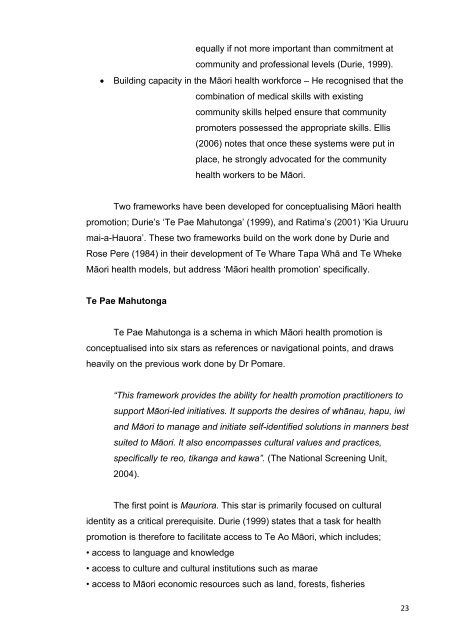Te Māoritanga WELLBEING AND IDENTITY Kapa Haka as a Vehicle
Te Māoritanga WELLBEING AND IDENTITY Kapa Haka as a Vehicle
Te Māoritanga WELLBEING AND IDENTITY Kapa Haka as a Vehicle
Create successful ePaper yourself
Turn your PDF publications into a flip-book with our unique Google optimized e-Paper software.
equally if not more important than commitment at<br />
community and professional levels (Durie, 1999).<br />
• Building capacity in the Māori health workforce – He recognised that the<br />
combination of medical skills with existing<br />
community skills helped ensure that community<br />
promoters possessed the appropriate skills. Ellis<br />
(2006) notes that once these systems were put in<br />
place, he strongly advocated for the community<br />
health workers to be Māori.<br />
Two frameworks have been developed for conceptualising Māori health<br />
promotion; Durie’s ‘<strong>Te</strong> Pae Mahutonga’ (1999), and Ratima’s (2001) ‘Kia Uruuru<br />
mai-a-Hauora’. These two frameworks build on the work done by Durie and<br />
Rose Pere (1984) in their development of <strong>Te</strong> Whare Tapa Whā and <strong>Te</strong> Wheke<br />
Māori health models, but address ‘Māori health promotion’ specifically.<br />
<strong>Te</strong> Pae Mahutonga<br />
<strong>Te</strong> Pae Mahutonga is a schema in which Māori health promotion is<br />
conceptualised into six stars <strong>as</strong> references or navigational points, and draws<br />
heavily on the previous work done by Dr Pomare.<br />
“This framework provides the ability for health promotion practitioners to<br />
support Māori-led initiatives. It supports the desires of whānau, hapu, iwi<br />
and Māori to manage and initiate self-identified solutions in manners best<br />
suited to Māori. It also encomp<strong>as</strong>ses cultural values and practices,<br />
specifically te reo, tikanga and kawa”. (The National Screening Unit,<br />
2004).<br />
The first point is Mauriora. This star is primarily focused on cultural<br />
identity <strong>as</strong> a critical prerequisite. Durie (1999) states that a t<strong>as</strong>k for health<br />
promotion is therefore to facilitate access to <strong>Te</strong> Ao Māori, which includes;<br />
• access to language and knowledge<br />
• access to culture and cultural institutions such <strong>as</strong> marae<br />
• access to Māori economic resources such <strong>as</strong> land, forests, fisheries<br />
23
















